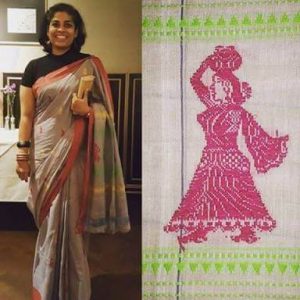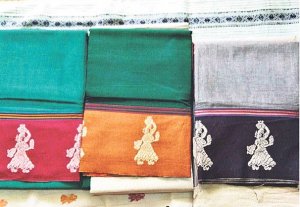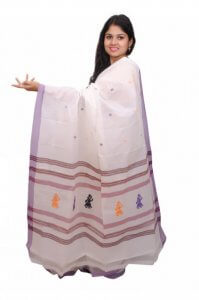Are you looking for Gollabhama Sarees – How They Are Made? then check out this post to know more.
The motif is the basic design which is present in the saree. The design, created by the weaver, goes through a meticulous process. The coloured threads are passed through the warp to get a clear design of motif. During the process, the loom strings are pulled down a thousand times and the pedal is swung down simultaneously. The weavers use the double thread technique, as the utilization of single thread is time-consuming.
The Gollabhama weaver neither embroidery nor print this designs but these motifs are scrupulously woven into the borders of the saree. Primarily the design is drawn on the graph, then using the set of 80 to 100 threads the pattern for the motif is created.
Siddipet gollabhama sarees
The specific position of threads is defined on the pattern. The specific areas are defined where the warps are raised and then the coloured threads are inserted. For each of the motif, while creating them, to get the resulting design the coloured threads are passed through the warp.
Siddipet weave is popularly called tie and dye weave. It is a unique technique due to its design and colours. These are transferred onto warp and weft threads which are then weaved together. Siddipet weavers use pure cotton as fabric material for saree.
The colours used in this saree are always the natural colours or related blends. When it comes to creating the motif, the weaver needs to meticulously pass the coloured thread through the warp to get a clear design which is time-consuming. “All this while pulling the looms strings thousands of time and swinging the pedal down simultaneously. It takes more time using a single thread, so weavers generally use the double thread technique.
The intricate Gollabhamas of these sarees are neither embroidered nor printed but are meticulously woven into the border of the saree. The design is initially drawn on a graph, and translated to a pattern using a set of 80-100 threads. These threads define the specific position where the warp is raised and coloured threads are inserted. While creating these motifs, the weaver passes coloured threads (for each motif) through the warp to achieve the resulting design.
Siddipet weave is popularly called the tie and dye weave. The uniqueness of these weaves lies in the transfer of the unique design and colour onto warp and weft threads. These are then weaved together. The fabric used for weaving purpose in Siddipet is pure cotton. The colours derived from natural sources and related blends are used in this form of weaving.
In the handlooms of Siddipet, the process of dyeing is tie and dye technique where the warp and weft are tie-dyed before these are weaved for creating unique designs on finished fabric. The key to obtain clarity in terms of design is the precision in the wrapping technique. These warp threads are dyed after the wrapping process is done.





